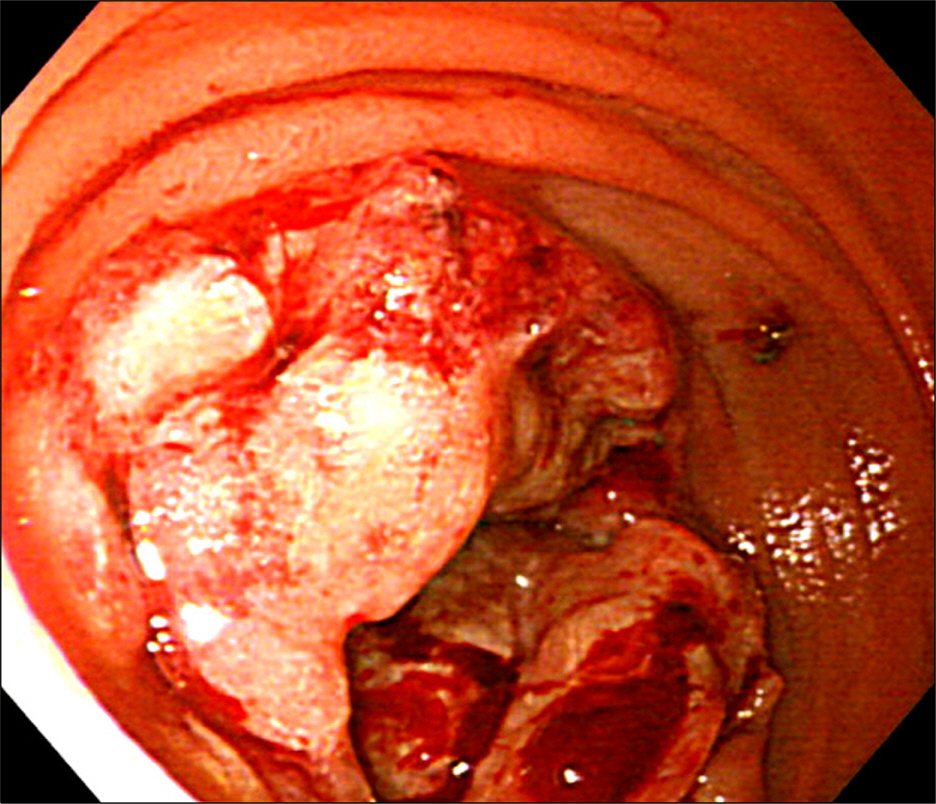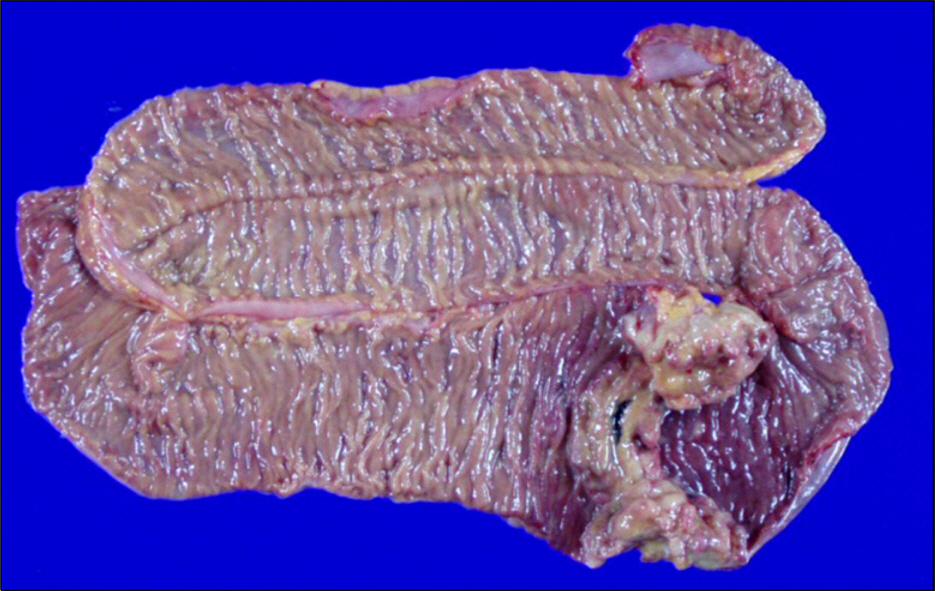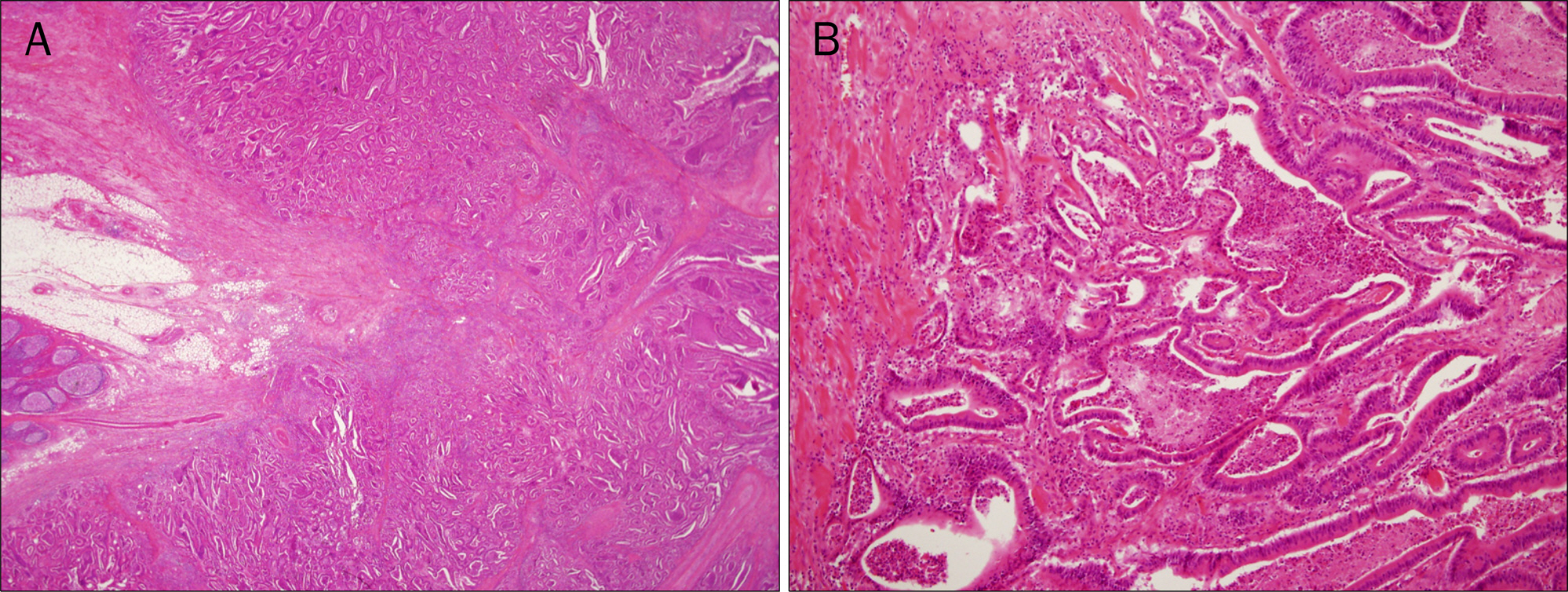Korean J Gastroenterol.
2011 Oct;58(4):217-220. 10.4166/kjg.2011.58.4.217.
Small Bowel Carcinoma in Young Patient Detected by Double-balloon Enteroscopy
- Affiliations
-
- 1Department of Internal Medicine, Korea University College of Medicine, Seoul, Korea. sungwoojung@korea.ac.kr
- 2Department of Surgery, Korea University College of Medicine, Seoul, Korea.
- 3Department of Pathology, Korea University College of Medicine, Seoul, Korea.
- KMID: 1718431
- DOI: http://doi.org/10.4166/kjg.2011.58.4.217
Abstract
- A 17-year old female presented with a chief complaint of melena and epigastric pain. She had a family history of colon cancer, her mother having been diagnosed with hereditary nonpolyposis colorectal carcinoma (HNPCC). After close examination including double-balloon enteroscopy, the patient was diagnosed with small bowel carcinoma, in spite of her young age. Here we report this rare case of small bowel carcinoma in a young patient with a family history of HNPCC.
MeSH Terms
Figure
Reference
-
References
1. Aarnio M, Mecklin JP, Aaltonen LA, Nyström-Lahti M, Järvinen HJ. Lifetime risk of different cancers in hereditary non-polyposis colorectal cancer (HNPCC) syndrome. Int J Cancer. 1995; 64:430–433.
Article2. Hampel H, Stephens JA, Pukkala E, et al. Cancer risk in hereditary nonpolyposis colorectal cancer syndrome: later age of onset. Gastroenterology. 2005; 129:415–421.
Article3. Lindor NM, Petersen GM, Hadley DW, et al. Recommendations for the care of individuals with an inherited predisposition to Lynch syndrome: a systematic review. JAMA. 2006; 296:1507–1517.4. Anaya DA, Chang GJ, Rodriguez-Bigas MA. Extracolonic manifestations of hereditary colorectal cancer syndromes. Clin Colon Rectal Surg. 2008; 21:263–272.
Article5. Lynch HT, Smyrk TC, Lynch PM, et al. Adenocarcinoma of the small bowel in lynch syndrome II. Cancer. 1989; 64:2178–2183.
Article6. Schulmann K, Engel C, Propping P, Schmiegel W. Small bowel cancer risk in Lynch syndrome. Gut. 2008; 57:1629–1630.
Article7. Winawer S, Fletcher R, Rex D, et al. Gastrointestinal Consortium Panel. Colorectal cancer screening and surveillance: clinical guidelines and rationale-Update based on new evidence. Gastroenterology. 2003; 124:544–560.
Article8. Rodriguez-Bigas MA, Vasen HF, Lynch HT, et al. Characteristics of small bowel carcinoma in hereditary nonpolyposis colorectal carcinoma. International Collaborative Group on HNPCC. Cancer. 1998; 83:240–244.9. Schulmann K, Brasch FE, Kunstmann E, et al. German HNPCC Consortium. HNPCC-associated small bowel cancer: clinical and molecular characteristics. Gastroenterology. 2005; 128:590–599.
Article10. Baichi MM, Arifuddin RM, Mantry PS. Metachronous small bowel adenocarcinomas detected by capsule endoscopy in a patient with hereditary nonpolyposis colorectal cancer. Dig Dis Sci. 2007; 52:1134–1136.
Article
- Full Text Links
- Actions
-
Cited
- CITED
-
- Close
- Share
- Similar articles
-
- Diagnostic and Therapeutic Capability of Double-Balloon Enteroscopy in Clinical Practice
- A Case of a Cavernous Hemangioma in the Distal Jejunum Detected by Double-Balloon Enteroscopy in a Patient with Small Bowel Obstruction
- The Usefulness of Double Balloon Enteroscopy for Diagnosis and Treatment of Small Bowel Diseases
- A Case of Inflammatory Myofibroblastic Tumor Diagnosed with Double-balloon Enteroscopy
- Small Bowel Metastatic Cancer Observed With Double Balloon Enteroscopy in a Patient With a Past History of Multiple Cancers






